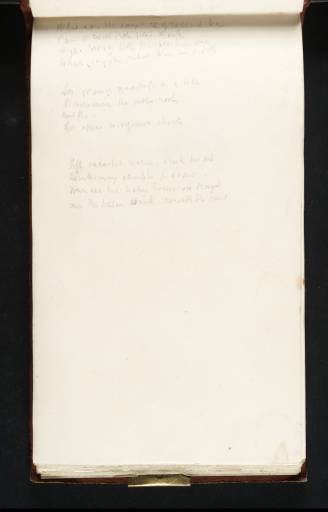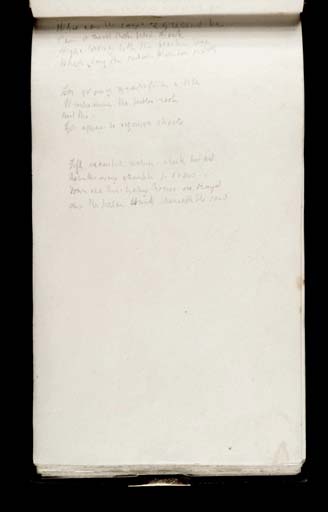Joseph Mallord William Turner Verses (Inscriptions by Turner) 1809
Image 1 of 2
Joseph Mallord William Turner,
Verses (Inscriptions by Turner)
1809
Joseph Mallord William Turner 1775–1851
Folio 85 Verso:
Verses (Inscriptions by Turner) 1809
D07847
Turner Bequest CXII 85a
Turner Bequest CXII 85a
Inscribed by Turner in pencil (see main catalogue entry) on white wove paper, 180 x 107 mm
Accepted by the nation as part of the Turner Bequest 1856
References
1909
A.J. Finberg, A Complete Inventory of the Drawings of the Turner Bequest, London 1909, vol.I, p.306, CXII, as ‘Draft of verses).
1990
Andrew Wilton and Rosalind Mallord Turner, Painting and Poetry: Turner’s ‘Verse Book’ and his Work of 1804–1812, exhibition catalogue, Tate Gallery, London 1990, pp.137, 167.
These verses were first transcribed by Rosalind Mallord Turner, whose reading is followed here:
What can the song of greatness be
Can it resist that fated shock
High towering like the beech tree
Which long the rudest blast does mock
Can it resist that fated shock
High towering like the beech tree
Which long the rudest blast does mock
In growing greatness as a tree
It undermines the feeble root
And tho
Yet appear to vigourous shoots
It undermines the feeble root
And tho
Yet appear to vigourous shoots
Till exhausted nature check her aid
Rebukes every attempt to draw
Down all her leafy honor are decayed
And the fallen trunk beneath the saw
Rebukes every attempt to draw
Down all her leafy honor are decayed
And the fallen trunk beneath the saw
Turner is meditating on creativity, criticism and the transient nature of reputation, and uses as his primary image a beech tree, growing to maturity but carrying within it the seeds of its own destruction as it outgrows its own strength. This is in keeping with the organic similes for creativity favoured by Romantic artists and writers. Wilton and Mallord Turner observe the ‘personal significance’ of the theme to Turner, without elaborating on what this might be.
Turner’s career was flourishing at this period but here he strikes a troubled, pessimistic note. His thoughts seem to chime with his reflections on the poet Alexander Pope and the damage done to his memory by the demolition in 1807 of his villa at Twickenham; these included extensive commentary in verse and his picture Pope’s Villa at Twickenham, during its Dilapidation (on the London art market in 2008)1 exhibited in 1808. It is interesting that in this sketchbook the lines occur close to drawings of trees, folios 82 verso and 83 verso (D07841, D07843) and others of Petworth Park, for example folio 5 (D07761), since Turner was later to choose the park, with Petworth House and church, as the background for his subject of a beech tree threatened by woodcutters in his vignette The Beech Tree’s Petition (watercolour in the National Gallery of Scotland, Edinburgh)2 for Thomas Campbell’s Poetical Works (1837).3 The design for the vignette could be based on folios 1 and 2 (D07757, D07758), possibly also showing the park or scenery nearby. There may have been some lasting connection in Turner’s mind between these ideas and places. Elsewhere in Sussex, notably in the east of the county, swathes of old woodland had been cut down for fuel for iron-smelting and other uses, leading to a shortage of timber.4
David Blayney Brown
June 2009
Martin Butlin and Evelyn Joll, The Paintings of J.M.W. Turner, revised ed., New Haven and London 1984, pp.55–6 no.72 (pl.82); Sotheby’s sale, 9 July 2008 (lot 91).
Turner illustrates the lines ‘Carved many a long forgotten name / Spare woodman spare the beechen tree’
How to cite
David Blayney Brown, ‘Verses (Inscriptions by Turner) 1809 by Joseph Mallord William Turner’, catalogue entry, June 2009, in David Blayney Brown (ed.), J.M.W. Turner: Sketchbooks, Drawings and Watercolours, Tate Research Publication, December 2012, https://www


